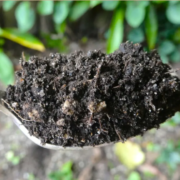Investigating Aotearoa’s e-waste footprint
Electronic waste is the world’s fastest growing waste stream, and in Aotearoa most of it ends up in landfill where it can leach toxins into soil and waterways. The good news is that we are taking steps to reduce our e-waste footprint. Bonnie Flaws investigates.
We hope you enjoy this free article from OrganicNZ. Join us for access to exclusive members-only content.
Mobile phones, old computers, toasters and jugs, whiteware, batteries, televisions, gadgets, even children’s toys. We’ve probably all gone through numerous editions of each of these products in our lifetime. I run a little inventory and establish that I am on my fifth mobile phone, my fifth computer, and probably my fourth television. I’m only on my second GHD though after 20 years of hair straightening – pretty good, I reckon. My 30-year-old dishwasher is working but it’s falling apart, and it won’t be long before I’ll be replacing it.
Electronic waste is increasing globally, and here in New Zealand it’s estimated we produce about 80,000 tonnes a year, of which only 2000 tonnes is recycled. “It’s a significant problem,” says AUT senior lecturer in the School of Future Environments, Jeff Seadon. And it’s everyone’s problem – it’s estimated each person produces about 21 kg every year, he tells me.

Reader support keeps us going
Please support our work by joining with a membership subscription (print or digital). Organic NZ is independently published by the Soil & Health Association, a charity devoted to healthy soil, healthy food and healthy people.
Our independent journalism relies on support from people like you!
What is it and why is there so much of it?
E-waste comprises “anything with a plug or battery” that has reached the end of its life, Jeff explains. As the world has become increasingly digitised, the amount of e-waste continues to pile up and it has become the fastest growing waste stream in the world. Another culprit is ‘planned obsolescence’, a business strategy with an ethics problem.
Manufacturers want repeat customers and so longevity is not a priority. It costs manufacturers money to repair products, and it’s often cheaper to simply replace broken items. It’s also profitable to dictate who can do repairs, sometimes under threat of nullifying the warranty if something is repaired by an unauthorised party.
“There is now a backlash occurring, and as a result, manufacturers are having to change their products so that there is a ‘right to repair’,” Jeff says. The ‘right to repair’ concept is becoming more widespread. Consumer NZ says it’s going mainstream, with companies like Apple making supportive noises, and legislators in Australia and the United Kingdom forcing manufacturers to repair cars through independent garages and supply spare parts for gadgets. Minister for the Environment David Parker is a fan and Kiwi businesses could soon be legally bound to ensure old devices can be repaired too.
Jeff says this policy may force a rethink. “Producers are thinking, ‘If we have to repair it, that will cost us a fortune and that will come back on us. So, therefore we need to make things that are more useable’.”
Environmental and health impacts
E-waste contains a variety of minerals and elements, including precious metals and heavy metals. Many of these are contaminants, says University of Canterbury professor of environmental chemistry Brett Robinson. Elements like lead, cadmium, mercury and copper bind very strongly to soils where they stay forever or are taken up by plants.
But Brett says there are many other chemical elements that are not well understood – such as gallium and indium, which are used in the manufacture of flat panel displays. It is not known just how mobile they are in soil or how harmful they can be. At some level, all of these contaminants are toxic to microbes and plants, he says.
Some types of flame retardants that are used in plastics on electronic devices are also extremely toxic and very mobile, so can leach into groundwater. Air pollution can also be a problem. “If e-waste is burned, you get chemicals called dioxins forming – the same chemical that caused environmental damage in Vietnam with Agent Orange.”
Brett says most of what is collected at recycling centres usually goes overseas to places like Japan, Singapore and South Korea, where it can be recycled more cost-effectively.
Sadly, in New Zealand most e-waste ends up in landfill. There are upsides and downsides to this, he adds. On the downside, resources are being lost – there is far more gold, silver and palladium in landfills than there is in virgin mines, such as the one in Waihi. On the upside, since the 1990s, landfills have been required to be sealed, so the e-waste doesn’t leach out, although some of it ends up as leachate which is collected and reprocessed by the operator, he says.
Farm dumps
The biggest problem in Aoteroa is the amount of e-waste illegally disposed of on farm dumps, of which there are estimated to be about 30,000 around the country, Jeff tells me. “It’s very hard to regulate because if you have a little valley in the back of beyond, who is going to be there to check it?”
Unlike landfills, these dumps do leach. As water passes through valleys, decaying metals pass into the water system and into vegetable and animal life, where it accumulates. Some elements can also get into groundwater, he says. Their accumulation in humans and animals via water and food can lead to side effects including kidney and bone disease, central nervous system damage and elevated blood pressure.
Product stewardship for e-waste will become mandatory
Spark, Vodafone and 2degrees have a recycling programme for phones called Re:Mobile, and there are collection points for e-waste recycling in many places that you can find out about through your local council or at ewaste.org.nz. However, options for responsible disposal of electronic waste are still limited. But this is set to change.
The Ministry for the Environment is currently in the process of setting up a product stewardship scheme under the Waste Minimisation Act, and e-waste is one of the priority waste streams. Once in place, it will oblige producers to recover e-waste at the end of life and recycle it. There is no date set yet for its implementation.
What we do know is that it will be a user-pays system. “When you go and purchase a piece of electronic equipment covered under the scheme, you’ll pay an extra amount that will pay for its recovery at the end. The scheme will build up money to capture goods at the end and it should be self-supporting,” Brett says.
Not-for-profit TechCollect NZ was established by a group of global technology companies to support the development of a regulated product stewardship scheme in New Zealand, and is working with the government on delivering the scheme at present.
Auckland based company Computer Recycling will likely to be collecting much of this waste once the scheme is up and running. Director Patrick Moynahan has imported a high-tech piece of kit called Blue Box. One of only eight in the world, this machine will increase the amount of e-waste the country currently recycles to 5000 tonnes per year, he says. “That will go quite a long way to recycle the ‘hard to recycle’ material – things like flat screens, small electronics, laptops. We’ll be able to handle the vast majority of what New Zealand produces,” he says. Hard-to-recycle material is anything that can’t be disassembled by hand,
he explains.
The $3 million machine, a 40 foot container-sized shredding unit, operates in a negative vacuum environment, meaning nasties like mercury and cadmium will be contained and the recycling process won’t contribute to the contamination of the workers or the land. The metals will be exported as commodities, where they will be reused in manufactured goods. It also separates out the precious metals into pure commodity streams that can be sold back to refineries.
Computer Recycling collects e-waste from all over the country at one-day-events via business networks and a fleet of trucks and vans that collect waste. “We also work with general waste companies to encourage the collection of e-waste at the point of landfill,” Patrick says. The company will be working with TechCollect and companies implementing the mandatory product stewardship programmes when the time comes.
But Patrick doesn’t think it will be realistically operational for two to three years. Once the regulation is in place, the e-waste recycling sector will expand significantly especially with the help of Blue Box, he says.
“We are hoping to import a few more machines [for other e-waste streams] in a couple of years. If stewardship is introduced and there is a conscious effort to educate the public then there is no reason why we can’t hit 50–60 per cent recycling of waste. Right now, we’re are at about 2 per cent,” Patrick says.







